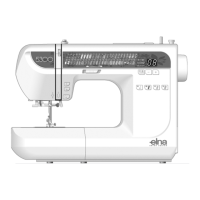Why are patterns distorted on my ELNA Sewing Machine?
- CChristopher WilliamsSep 14, 2025
Patterns may be distorted on your ELNA Sewing Machine if the stitch is not balanced.

Why are patterns distorted on my ELNA Sewing Machine?
Patterns may be distorted on your ELNA Sewing Machine if the stitch is not balanced.
| Brand | ELNA |
|---|---|
| Model | 5300 |
| Category | Sewing Machine |
| Language | English |
Instructions to reduce the risk of electric shock when using the sewing machine.
Instructions to reduce the risk of burns, fire, electric shock, or injury to persons.
Instruction to save safety precautions for future reference.
List and identification of all machine components with corresponding numbers.
List of standard accessories provided with the sewing machine, with storage information.
Details on the extension table and its use for free arm sewing.
Instructions for connecting the sewing machine to the power supply.
Safety precautions regarding power cord usage and wet hands.
How to adjust the maximum sewing speed using the slider.
How sewing speed is varied by pressing the foot control.
How to adjust the presser foot pressure for different fabrics.
Using the reverse key for backstitching and locking stitches.
Using the auto-lock key to secure stitches automatically.
Controlling the needle's up and down position.
Selecting stitch patterns using the mode key and pattern chart.
Adjusting the stitch width using the mode and +/- keys.
Adjusting the stitch length using the mode and +/- keys.
Quickly selecting commonly used stitches via dedicated keys.
Procedure for attaching and removing presser feet.
Procedure for attaching and removing the presser foot shank.
How to adjust needle thread tension for optimal stitch quality.
Guidance on choosing the right needle type for different fabric types.
Descriptions of various needle types including Universal, Ball point, Denim, Stretch, Leather, Topstitching, and Twin/Double.
Step-by-step guide to threading the machine for bobbin winding.
How to place the spool of thread on the spool pin.
Procedure for bringing up the bobbin thread to the needle area.
Covers machine settings, starting, changing direction, and finishing straight stitch seams.
How to adjust the needle's horizontal position.
Techniques for sewing through multiple layers of heavy fabric.
Description of straight stitch patterns #01 and #02 and recommended foot.
Description of lock-a-matic stitch for securing seams.
Description of locking stitch for invisible finishing.
Machine settings for gathering: Pattern, Presser foot, Tension.
Machine settings for zipper insertion: Pattern, Presser foot, Tension.
Instructions for applying lapped zippers, typically in side seams.
Steps for preparing fabric for zipper insertion, including marking and basting.
Machine settings for zigzag stitch: Pattern, Presser foot, Tension.
How to adjust stitch width for the zigzag stitch.
How to adjust stitch length for the zigzag stitch.
Machine settings for overcasting stitch: Pattern, Presser foot, Tension.
Machine settings for satin stitch applique: Pattern, Presser foot, Tension, Pressure.
Machine settings for overcasting stitch: Pattern, Presser foot, Tension.
Machine settings for double overcasting stitch: Pattern, Presser foot, Tension.
Description and use of the classic buttonhole stitch.
Description and use of the rounded buttonhole stitch.
Description and use of the keyhole buttonhole stitch.
Machine settings for classic buttonhole: Pattern, Presser foot, Tension.
Step-by-step guide to sewing a classic buttonhole.
How to adjust the density of the buttonhole stitches.
Instructions for sewing a sturdy, layered buttonhole.
Adjusting width for rounded and keyhole buttonholes.
Specific instructions for adjusting keyhole buttonhole width.
Machine settings for corded buttonhole: Pattern, Presser foot, Tension.
Machine settings for button sewing: Pattern, Presser foot, Tension, Feed dog.
Machine settings for darning: Pattern, Presser foot, Tension.
Setting the darning length memory.
Adjusting darning evenness using +/- keys.
Machine settings for blind hem stitches: Pattern, Foot, Tension.
Steps for sewing blind hems on woven fabrics.
Recommended stitch for swimwear and stretch velour for durability.
Pretty hem finish for lingerie and tricot fabrics.
Decorative stitch for appliques, monograms, and floral designs.
Machine settings for applique sewing: Pattern, Foot, Tension, Pressure.
Machine settings for pattern combination: Pattern, Presser foot, Tension.
Procedure for replacing the machine's light bulb.
Warning regarding replacing the light bulb, noting potential heat.
Warning to turn off power before cleaning and not dismantle machine.
Note to ensure needle and presser foot are attached after cleaning.
Table listing warning signals, their causes, and suggested solutions.
Table listing audible signals and their meaning (normal operation, errors).
Causes and references for needle thread breakage.
Causes and references for bobbin thread breakage.
Causes and references for needle breakage.